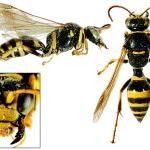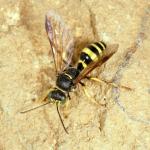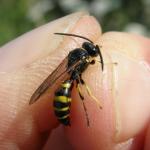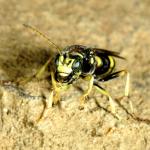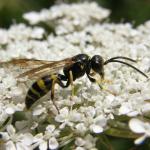The rarest of the British species of Gorytes.
Recorded sparingly over southern England (Devon, Dorset, Wiltshire, Hampshire, Kent, Essex, Cambridgeshire, Suffolk and Norfolk). In the Channel Islands, found on Guernsey, Herm and Sark. Abroad, widely distributed in the western Palaearctic region, eastwards to the Kirgizian steppes and southwards to Africa (Lomholdt, 1975-1976).
Listed as Rare (RDB3) in Shirt (1987) and by Falk (1991). The wasp may have declined, but it appears to have habits that render it somewhat elusive - few records have been submitted to the BWARS recorder.
Usually associated with rough vegetation such as brambles in open situations (heathland, scrub, coastal dunes, coastal landslips and soft rock cliffs), quarries and occasionally gardens. Typically observed running over brambles and other low herbage.
Mid-June to mid-August.
Nesting occurs in light soils. P F Yeo observed a female excavating nests in the soft mortar between paving stones in his Cambridgeshire garden. The female made several excavations each day. Hamm & Richards (1930) cite a foreign account of a nest in a flower-pot. The main nest tunnel extends about 10 cm down into the soil (at which point it may continue a small distance upwards), giving rise to 3-4 short side tunnels with terminal cells (Lomholdt, 1975-1976). The cells are stocked with auchenorhynchus bugs such as Philaenus spumarius, Cercopis spp. and Aphrophora alni.
Umbellifers such as wild parsnip (Pastinaca sativa), carrot (Daucus carota), hogweed (Heracleum sphondylium) and water-dropworts (Oenanthe sp.). In France, Bitsch et al. (1997) also list angelica (Angelica species).
The nyssonine wasps Nysson trimaculatus and N. spinosus, and the sarcophagid fly Metopia campestris are noted as cleptoparasites on the Continent (Lomholdt, 1975-1976).


